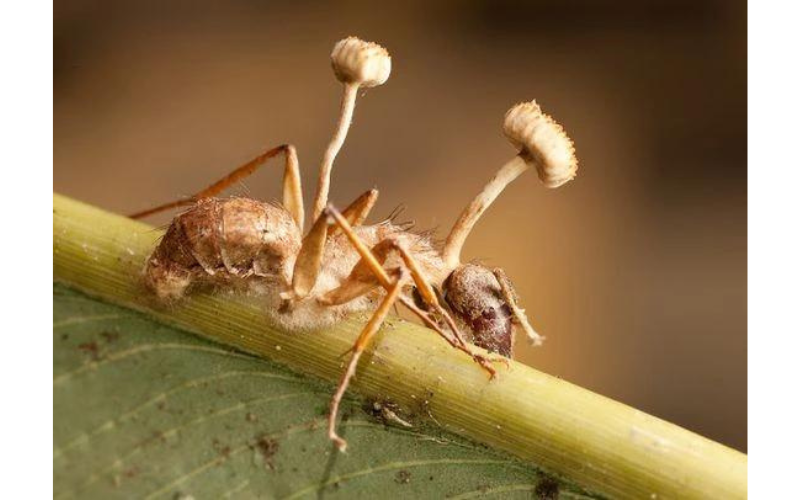
In the grand theater of nature, a peculiar player exists that commands a performance as captivating as it is eerie. Enter Cordyceps, a parasitic fungus that quite literally takes over the body of its host, guiding it to an untimely death so it can produce more spores and infect more hosts. But don’t let its macabre act fool you. Beneath its chilling life cycle, the Cordyceps fungus harbors a wealth of health benefits that are as remarkable as its parasitic tendencies. In this article, we’ll unravel the intriguing world of Cordyceps, a fungus that’s technically not a mushroom, yet a potent source of vitality. Brace yourself into the paradoxical existence of this life-giving ‘zombie fungus.’
What are Cordyceps?
Cordyceps is a genus within the fungi kingdom, encompassing over 400 recognized species. These fascinating organisms are celebrated for their extraordinary life cycle and the captivating manner in which they interact with their hosts. It’s important to note that most Cordyceps species are technically not mushrooms. Just as a flower can bloom, a mushroom can “shroom,” producing a fruiting body that we typically recognize and consume. However, Cordyceps do not “shroom” in the traditional sense, as they do not produce a typical mushroom cap. Instead, they have their own unique way of fruiting. Among the numerous species of Cordyceps, two have gained significant attention for their health benefits and usage in traditional medicine: Cordyceps sinensis and Cordyceps Militaris.
Before we delve into the specifics of these two fascinating species, let’s take a moment to understand what Cordyceps are in a broader sense.
Cordyceps are a type of parasitic fungi that infect various insects and other arthropods. They are part of the Ascomycota phylum, a large group of fungi characterized by their spore-producing structures known as asci.
These fungi thrive in a variety of environments, but most species prefer humid, tropical forests and soils rich in organic matter. The life cycle of Cordyceps is nothing short of fascinating. They begin their life as tiny spores, which, when they land on a suitable host, germinate and invade the host’s body. The fungi then grow and develop inside the host, eventually taking over and killing the host. The mature Cordyceps then emerges from the host’s body to release more spores, continuing the cycle.
While this might sound like something out of a horror movie, it’s important to remember that nature often has a dual nature. Despite their somewhat gruesome life cycle, Cordyceps, particularly Cordyceps sinensis and Cordyceps militaris, have been used for centuries in traditional medicine for their health benefits, which we’ll explore later in this article.
Cordyceps Sinensis: The Caterpillar Fungus
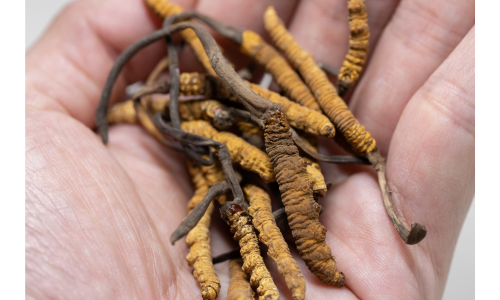
Cordyceps Sinensis, often referred to as the caterpillar fungus, is one of the most well-known species of the Cordyceps genus. This species is native to the high-altitude regions of China, Nepal, and Tibet, where it thrives in cool, humid environments.
The life cycle of Cordyceps Sinensis is nothing short of fascinating. It begins its life as a spore that infects various insects, particularly caterpillars. Once infected, the fungus takes over the host’s body, eventually leading to the host’s death. The fungus then grows out of the deceased host, producing a fruiting body that looks like a caterpillar with a long, thin mushroom growing out of its head. This unique appearance is the reason behind its nickname, the caterpillar fungus.
Cordyceps Sinensis Price
Due to its specific growing conditions and the complexity of its life cycle, Cordyceps sinensis is quite rare and difficult to harvest, making it one of the most expensive mushrooms in the world. The price can range from $20,000 to $40,000 per kilogram, depending on the quality. To put this into perspective, a daily dose of a Cordyceps sinensis supplement could cost anywhere from $1 to $5, and a cup of tea made from this mushroom could cost upwards of $10.
The Zombie Ant Phenomenon: Nature’s Own Horror Story
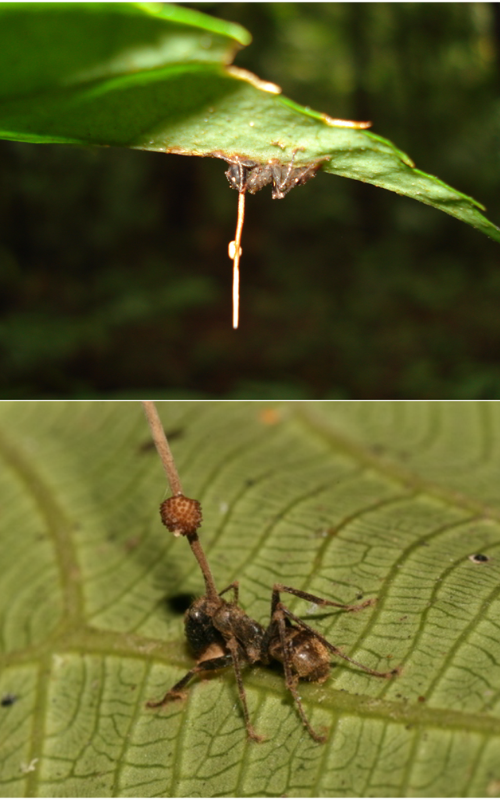
Now, let’s delve into the eerie part of Cordyceps sinensis’s life cycle. While it’s known to infect caterpillars, it can also infect ants. In this case, the fungus doesn’t hijack the ant’s brain but rather its body. The ant’s brain remains the same, but its body is completely controlled by the fungus, turning it into a mere puppet. It’s really scary when you think about it. Imagine fungi completely taking over your entire body, but your brain still functioning normally.
The infected ant, under the influence of the fungus, embarks on a strange journey. It is guided to a specific location, usually on a leaf facing north, where it bites down on the vein of the leaf with an unyielding grip. This final act, known as the “death grip,” is the ant’s last conscious action before it succumbs to the fungus.
As the ant dies, the fungus begins its next phase. It grows out of the ant’s head, forming a long stalk that eventually releases spores. These spores then drift down to the colony below, infecting other ants and continuing the cycle.
This phenomenon, eerily reminiscent of a horror movie plot, has earned Cordyceps the nickname “zombie fungus.” As chilling as it may sound, it’s a testament to the remarkable adaptability and survival strategies of fungi. It’s a stark reminder of the intricate and sometimes ruthless dance of life and death that plays out in nature. The concept is so compelling that it even inspired an HBO series, “The Last of Us.”
Medical Uses of Cordyceps sinensis
Despite its eerie life cycle, C sinensis is highly valued for its medicinal properties. It has been used in traditional Chinese medicine for centuries to treat various conditions, including fatigue, respiratory illnesses, and kidney diseases. Recent research has also shown that Cordyceps Sinensis may have potential benefits for heart health, the intestinal immune system function, and athletic performance. However, more research is needed to fully understand the extent of its health benefits.
Cordyceps Militaris: The Lab-Grown Powerhouse
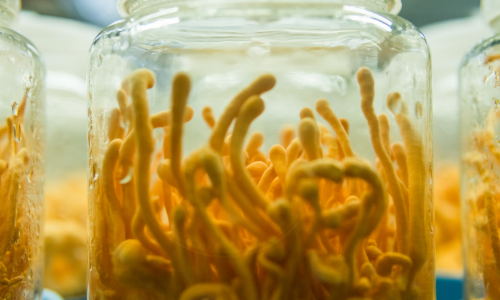
Cordyceps Militaris is another species of Cordyceps that has gained significant attention, particularly because it can be cultivated in laboratory conditions, unlike its cousin, Cordyceps sinensis. This makes it more accessible and less expensive, though it still carries a hefty price tag due to its potent benefits.
Naturally, Cordyceps Militaris prefers to grow in humid climates and is found in many parts of the world, including the United States, Europe, and Asia. Unlike Cordyceps sinensis, which primarily infects caterpillars, Cordyceps militaris is known to infect a variety of insects, including ants and beetles.
In the lab, Cordyceps Militaris is grown on a substrate such as rice or grain, which allows for control over the growing conditions and ensures a consistent product. This method of cultivation also allows for the production of a pure mycelium product without the presence of any insect material.
Cordyceps Militaris Price
The price of Cordyceps Militaris can vary, but it’s generally less expensive than Cordyceps Sinensis. For example, a bottle of Cordyceps Militaris supplements can range from $20 to $50, depending on the brand and the concentration of the product. As for a cup of C Militaris tea, it would depend on the concentration of the powder used, but you could expect to pay anywhere from $1 to $3 per cup.
In terms of benefits, Cordyceps Militaris shares many of the same properties as Cordyceps Sinensis. It’s known for its energy-boosting effects and is often used by athletes to improve performance and recovery. It also has immune-boosting properties and is used to support overall health.
However, there are some differences between the two species. While both are used to enhance energy and support the immune system, C Militaris has been found to have higher levels of certain compounds, such as cordycepin, which is known for its anti-cancer and anti-inflammatory properties.
In the supplement market, Cordyceps Militaris is becoming more common due to its ease of cultivation and potent benefits. However, it’s always important to choose a reputable brand to ensure you’re getting a high-quality product.
The life cycle of Cordyceps Militaris is as fascinating as that of Cordyceps sinensis. The fungus infects an insect host, takes over its body, and eventually grows out of the insect, releasing spores to infect other hosts. This process, while gruesome, is a testament to the incredible adaptability and survival strategies of fungi.
In conclusion, while Cordyceps Militaris may not have the same mystique as its rare and expensive cousin, it’s a powerful supplement in its own right. Its ease of cultivation and potent health benefits make it a popular choice for those seeking to enhance their health and performance.
Unveiling the Historical Background of Cordyceps
The history of Cordyceps is as fascinating as its life cycle. This unique fungus has been a part of traditional medicine for centuries, particularly in countries like China, Tibet, and Nepal. The name “Cordyceps” itself is derived from the Latin words “cord” and “ceps,” meaning “club” and “head,” respectively, a nod to the club-like shape of the fungus.
Cordyceps was first documented in the medical text of ancient Tibet over a thousand years ago. However, it was not until the 15th century, during the Ming Dynasty in China, that its medicinal use became more widespread. The fungus was used as a tonic for longevity, to treat fatigue, and to boost lung and kidney function.
The rarity of Cordyceps, particularly Cordyceps sinensis, which grows naturally in the high-altitude regions of the Himalayas, contributed to its high value. It was often reserved for the emperor and the nobility. Today, Cordyceps is cultivated in laboratory conditions, making it more accessible and affordable.
The Biomechanics of Cordyceps
When you consume Cordyceps, it sets off a fascinating chain of events inside your body. Let’s take a closer look at this journey, breaking down the science into easy-to-understand terms:
The Starting Line – Absorption: Imagine Cordyceps as a team of tiny athletes. When you ingest these athletes, they’re absorbed into your bloodstream through your digestive system, ready to start their race through your body.
The Relay – Distribution: Once in your bloodstream, these athletes (the active compounds in Cordyceps) are passed like a baton to various parts of your body. The key players here are cordycepin, adenosine, and polysaccharides.
Cordycepin: This compound is like the sprinter of the team. It’s structurally similar to adenosine, a component of DNA, and can interfere with the process of gene transcription, potentially slowing down the growth of cancer cells.
Adenosine: Adenosine is the marathon runner. It plays a crucial role in energy transfer as part of ATP (adenosine triphosphate) and ADP (adenosine diphosphate), and in signal transduction as cyclic adenosine monophosphate (cAMP).
Polysaccharides: These are the weightlifters. They’re large molecules that can stimulate the immune system, helping to keep your body’s defenses strong.
The Finish Line – Action on Cells: The final leg of the race happens at a cellular level. Here, Cordyceps really shines. It’s believed to enhance the production of ATP, your body’s energy currency. Think of ATP as the cash you need to buy anything in your body, from a muscle contraction to a thought. By boosting ATP, Cordyceps essentially gives your cells more purchasing power, improving their function and your overall energy levels.
This is a simplified explanation of a complex process, but it gives you an idea of how Cordyceps works in your body. Remember, everyone’s body is different, and the effects of Cordyceps can vary from person to person.
What Exactly is ATP?

ATP, or Adenosine Triphosphate, is often referred to as the “energy currency” of the cell. It’s a molecule that stores and transports chemical energy within cells. ATP is produced by the food we eat, and its energy is used for a variety of bodily functions, including muscle contraction, nerve impulse propagation, and chemical synthesis.
Now, let’s talk about how Cordyceps comes into play. Cordyceps has been shown to enhance the body’s production of ATP. This is particularly beneficial for those who engage in high-intensity workouts or sports, as increased ATP production can lead to improved muscle strength, endurance, and recovery.
Here’s a simple way to understand it: Imagine your body is like a city, and ATP is the electricity that powers it. Everything in the city, from the lights in the buildings to the trains in the subway, needs electricity to function. Similarly, everything in your body, from your beating heart to your thinking brain, needs ATP to work.
Cordyceps acts like a power plant, boosting the production of ATP. This means more energy is available for your body to use, improving your performance in various tasks, from running a marathon to acing an exam. It’s like upgrading your city’s power plant, so there’s more electricity to go around, and everything runs more efficiently.
Potential Health Benefits
let’s delve into the potential health benefits of Cordyceps, a unique fungus that’s gaining recognition for its potent adaptogenic properties and its role as a nootropic supplement. The primary focus here is its remarkable ability to enhance energy levels, primarily through the increase of ATP production. Here’s a breakdown of the key cordyceps benefits here:
Boosting Exercise Performance: Cordyceps is most renowned for its potential to enhance energy levels. It’s believed to increase the body’s production of adenosine triphosphate (ATP), which is integral for delivering energy to the muscles, as we discussed above. This could improve the way your body uses oxygen, especially during exercise, leading to enhanced overall performance. Additionally, it may increase the body’s oxygen capacity, further boosting energy levels.
Adaptogenic Nootropic Benefits: Cordyceps is also an adaptogen, helping the body respond to various types of stress and promoting mental clarity. It’s being studied for its potential to support cognitive function, memory, and mood. For a comprehensive review of the Best Nootropic Supplements, CLICK HERE!
Anti-Cancer Properties: Preliminary studies suggest Cordyceps might have anti-tumor effects. Compounds in Cordyceps have been found to disrupt the cell cycle and induce apoptosis in human cancer cells, including lung and breast cancer cells. More research is needed to confirm these effects in humans.
Supporting Lung Health: Cordyceps has been used traditionally to support respiratory health. It may help improve lung function and could be beneficial for conditions such as chronic bronchitis and asthma. Some research also suggests it might have potential benefits in combating lung cancer, though more studies are needed to confirm these effects.
Promoting Nitric Oxide Production: Cordyceps may stimulate the production of nitric oxide, a molecule that plays a crucial role in immune and cardiovascular health. Nitric oxide helps expand blood vessels, improving circulation and potentially enhancing athletic performance.
Immune System Support: Cordyceps may stimulate the production of immune cells like T lymphocytes and natural killer cells, potentially enhancing the body’s ability to fight off infections and diseases.
Heart Health Potential: Some research indicates that Cordyceps could have beneficial effects on heart health, including the potential to treat chronic heart conditions and reduce heart damage.
Anti-Inflammatory Effects: Cordyceps has been studied for its potential anti-inflammatory benefits, which could be beneficial in managing conditions characterized by chronic inflammation.
Liver Health Benefits: Studies suggest that Cordyceps could help treat liver fibrosis and improve liver function, particularly in individuals with chronic liver diseases.
Blood Sugar Regulation: Cordyceps might help regulate blood sugar levels, potentially beneficial for individuals with diabetes.
Clinical Trials
As we delve deeper into the potential benefits of Cordyceps, it’s important to highlight the scientific research that supports these claims. Numerous clinical trials have investigated the effects of Cordyceps on various aspects of health, from exercise performance and cognitive function to cancer cell growth and chronic fatigue syndrome. These studies provide valuable insights into how this unique fungus works and it’s potential for enhancing our health and well-being. Let’s take a closer look at some of these compelling studies and their findings.
A study published in the Journal of the International Society of Sports Nutrition in 2017 found that supplementation with cordyceps improved aerobic performance in amateur marathoners. The study involved 30 amateur marathoners who were randomly assigned to either a group that took 2 grams of cordyceps per day or a group that took a placebo. After 12 weeks, the group that took cordyceps showed significant improvements in their aerobic performance, as measured by their VO2 max.
A study published in the journal PLOS One in 2015 found that supplementation with cordyceps improved cognitive function in elderly adults. The study involved 60 elderly adults who were randomly assigned to either a group that took 3 grams of cordyceps per day or a group that took a placebo. After 12 weeks, the group that took cordyceps showed significant improvements in their cognitive function, as measured by their performance on a battery of cognitive tests.
A study published in the journal Cancer Letters in 2016 found that supplementation with cordyceps inhibited the growth of cancer cells in vitro. The study involved human breast cancer cells that were exposed to cordyceps extract. The cordyceps extract was found to inhibit the growth of the cancer cells by up to 80%.
A study published in the journal Evidence-Based Complementary and Alternative Medicine in 2017 found that supplementation with cordyceps improved the symptoms of chronic fatigue syndrome. The study involved 60 people with chronic fatigue syndrome who were randomly assigned to either a group that took 3 grams of cordyceps per day or a placebo group. After 12 weeks, the group that took cordyceps showed significant improvements in their symptoms, as measured by their fatigue scores.
How Do Cordyceps Make You Feel?

So, you’re probably wondering, “What’s it like to take cordyceps?” Well, let’s break it down.
First off, cordyceps are adaptogens, which are a bit like nature’s stress-busters. They help your body handle stressand get back to a balanced state. This means that after taking cordyceps, you might feel a bit more energetic and ready to take on the world. This is likely because cordyceps help boost ATP production, which is basically your body’s energy currency.
But it’s not just about physical energy. Cordyceps are also said to give your brain a bit of a boost. People often report feeling more focused and clear-headed, making tackling tasks and staying productive easier. This makes cordyceps a go-to for students cramming for exams, professionals meeting tight deadlines, or anyone who needs to stay sharp.
Now, everyone’s different, so while some might feel these effects pretty quickly, others might need to take cordyceps consistently for a while before they start to notice the benefits.
And let’s not forget the athletes out there. Cordyceps have been reported to help improve endurance and fight off fatigue, making those long workouts or races a bit more manageable.
Finally, lots of folks taking cordyceps report just feeling healthier overall. This could be due to the wide range of health benefits cordyceps offer, from giving your immune system a boost to helping keep your lungs healthy.
Side Effects of Cordyceps: No, You Won’t Turn Into a Zombie
Before we dive into the potential side effects of Cordyceps, let’s clear up one thing: despite the ‘zombie ant’ phenomenon, there’s no need to worry about mushrooms sprouting from your head after consuming Cordyceps! That’s strictly a horror movie scenario (and a pretty good one at that). Now that we’ve got that out of the way, let’s discuss the real potential side effects of Cordyceps.
While Cordyceps is generally considered safe for most people, some individuals may experience mild side effects. These can include:
Digestive upset: Some people may experience nausea, diarrhea, or dry mouth after consuming Cordyceps.
Blood thinning: Cordyceps may slow blood clotting, which could increase the risk of bleeding in people with bleeding disorders or those taking certain medications.
Hypoglycemia: Cordyceps might lower blood sugar levels, which could interfere with diabetes medications or cause problems for people with hypoglycemia.
Immune system effects: Since Cordyceps can stimulate the immune system, it could cause problems for people with auto-immune diseases.
Cordyceps Supplements: From Traditional Use to Modern Forms
Cordyceps, with its rich history in traditional medicine, has been consumed in various ways over the centuries. Traditionally, in places like Tibet and China, Cordyceps sinensis was often simmered in duck or chicken broth to create a medicinal soup. This method not only made the fungus palatable but also facilitated the extraction of beneficial compounds. Fast forward to today, and we have more convenient and accessible forms of this fascinating fungus:
Capsules/Pills: These are perfect for those who value convenience and consistency. Each capsule or pill contains a specific amount of Cordyceps powder or extract, making it easy to monitor your intake.
Powder: Cordyceps powder offers versatility. It can be mixed into drinks, smoothies, or food, allowing you to get creative with your supplementation. The taste is mildly earthy, reminiscent of mushrooms.
Tea: Steeping dried Cordyceps mushrooms in hot water creates a unique tea with a slightly sweet and earthy flavor. While it’s not clear if Cordyceps was traditionally consumed as a tea, this method of consumption has become popular in recent years.
Regardless of the form you choose, it’s important to remember that Cordyceps should not be consumed raw due to potential exposure to harmful bacteria or other contaminants. Always ensure your Cordyceps are properly prepared, whether that means they are cooked, dried, or processed into a supplement.
How to Take Cordyceps Supplements?
Navigating the world of cordyceps supplements can be a bit tricky, but don’t worry, we’ve got you covered. Here’s what you need to know to get the most out of your cordyceps supplement regimen.
Dosage: The dosage for cordyceps supplements can vary based on the specific product and your individual health goals. A common starting point is between 1,000 to 3,000 milligrams per day. It’s wise to start on the lower end and gradually increase as your body acclimates.
Timing: Cordyceps supplements can be taken at any point during the day. However, due to their potential to boost energy levels, many people find it beneficial to take them in the morning or early afternoon. Taking them too close to bedtime could potentially interfere with sleep.
Cycling: Some health experts suggest cycling your cordyceps supplements. This means taking them for a set period, say 2-3 weeks, and then taking a break for a week. Cycling can help prevent your body from becoming too accustomed to the supplement, which could diminish its effectiveness over time.
Choosing a Quality Cordyceps Supplement
When it comes to choosing a quality Cordyceps supplement, there are a few key factors to consider. First and foremost, you’ll want to look for a supplement that uses Cordyceps militaris. This species is not only more sustainable and ethical than Cordyceps sinensis, but it also has a higher concentration of beneficial compounds.
One of the most important compounds to look for is Beta-Glucan (β-Glucan). This is a type of polysaccharide that has been shown to have immune-boosting properties. A quality Cordyceps supplement should have a minimum β-Glucan content of 25%.
Another important compound is cordycepin. This is a bioactive compound or “phytochemical” that is unique to Cordyceps and has been shown to have a range of health benefits. Look for a supplement that has a cordycepin content of at least .2% as confirmed by High-Performance Liquid Chromatography (HPLC), a technique used to identify and quantify the components in a mixture.
In addition to these compounds, you’ll want to look for a supplement that uses the whole fruiting body of the Cordyceps. The fruiting body is the part of the fungus that contains the highest concentration of beneficial compounds. Some supplements use mycelium on grain, which can dilute the concentration of beneficial compounds.
Lastly, always choose a reputable brand that is transparent about their sourcing and production methods. This ensures that you’re getting a high-quality, ethically-produced supplement.
Nootropics Depot’s Cordyceps Militaris Capsules
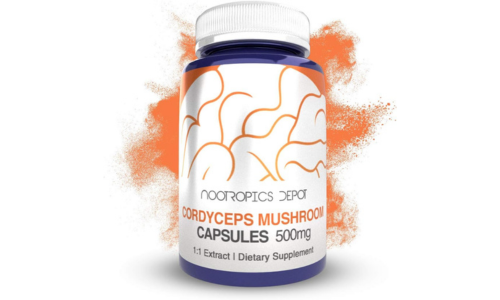
In my search for a high-quality Cordyceps supplement, I’ve found that Nootropics Depot’s Cordyceps Militaris Whole Fruiting Body Medicinal Mushroom Extract Capsules stand out. This product aligns perfectly with the quality standards we discussed earlier.
These capsules are derived from the Cordyceps Militaris species, known for its higher levels of beneficial cordycepin. The product is a whole fruiting body extract, ensuring you get all the beneficial compounds.
What’s more, it meets the key standards for a quality Cordyceps supplement. It boasts a minimum Beta-Glucan (β-Glucan) content of 25% and a Cordycepin content of .2% by HPLC.
Nootropics Depot is a trusted company with a reputation for rigorously testing its products for quality. Their Cordyceps Militaris capsules have been lab-tested and verified for both product purity and identity.
So, if you’re considering a Cordyceps supplement, Nootropics Depot’s Cordyceps Militaris Capsules is a solid choice that meets all the right criteria. Check them out here.
What Stacks Best With Cordyceps?
When it comes to stacking Cordyceps with other nootropics for enhancing athletic performance and overall well-being, several options are highly rated by the scientific community and users alike. Here are a few you might consider:
- Rhodiola Rosea: Known for its stress-busting and fatigue-fighting properties, Rhodiola Rosea is a powerful adaptogen that can pair well with Cordyceps. It can help improve mental performance under stress, making it a popular choice among athletes and busy professionals.
- Lion’s Mane: This medicinal mushroom is famous for its potential cognitive-enhancing benefits. Stacking Lion’s Mane with Cordyceps could offer a combination of improved mental clarity and physical performance.
- Bacopa Monnieri: Known for its memory-enhancing properties, Bacopa Monnieri can complement the physical performance benefits of Cordyceps by boosting cognitive function.
- Panax Ginseng: Used in traditional Chinese medicine for centuries, Panax Ginseng can help increase energy levels and improve physical stamina, making it a fitting companion for Cordyceps.
For a full article on Adaptogens, CLICK HERE!
While all these options can potentially offer added benefits when stacked with Cordyceps, your personal recommendation of Rhodiola Rosea from Nootropics Depot and Genius Mushroom are also excellent choices. Both have received positive reviews from users and are known for their quality and efficacy.
Wrapping Up Our Cordyceps Journey
From the eerie forests where Cordyceps commandeers insects to the labs where its health benefits are being explored, we’ve covered a lot of ground. This unique fungus, boosting ATP production and potentially aiding in everything from exercise performance to cancer treatment, is more than just a biological curiosity. It’s a potent supplement with a wealth of potential benefits.
Remember, quality matters when choosing a Cordyceps supplement, and it’s always wise to consult with a healthcare professional. Cordyceps could be a valuable addition to your wellness journey, offering a natural approach to health enhancement. Here’s to the wonders of nature, the potential of natural medicine, and the health benefits yet to be discovered!
FAQ’s
Q: Can Cordyceps help with liver fibrosis?
A: Some preliminary research suggests that Cordyceps may have potential benefits for treating liver fibrosis, a condition characterized by the excessive accumulation of scar tissue in the liver. However, more research is needed to confirm these effects in humans.
Q: What are the potential benefits of Cordyceps for cancer patients?
A: Lab studies suggest Cordyceps may have anti-cancer properties, potentially inhibiting the growth of various types of cancer cells, including lung, breast, and liver cancer cells. Some research also suggests that Cordyceps may enhance the effects of certain cancer treatments. However, more human research is needed in this area.
Q: Can Cordyceps help with chronic renal failure?
A: Some research suggests that Cordyceps may have potential benefits for people with chronic renal failure, possibly by improving kidney function. However, more research is needed to confirm these effects in humans.
Q: What are the potential benefits of Cordyceps for renal transplant patients?
A: While research is limited, some studies suggest that Cordyceps may help improve kidney function and reduce the risk of infection in renal transplant patients. However, it’s important to consult with a healthcare provider before starting any new supplement regimen, especially for transplant patients.
Q: Can Cordyceps help boost testosterone production?
A: Some animal studies suggest that Cordyceps may help boost testosterone production, potentially improving sexual function and performance. However, more human research is needed to confirm these effects.
Q: What are the potential adverse effects of taking Cordyceps?
A: Cordyceps are generally considered safe for most people. However, they may cause mild side effects like stomach upset, diarrhea, or dry mouth in some people. In rare cases, Cordyceps may cause more serious side effects, especially when taken in large doses or for a long period of time.
Q: Can Cordyceps help with inflammatory diseases?
A: Cordyceps contain bioactive compounds that have anti-inflammatory effects, which may potentially benefit people with inflammatory diseases. However, more research is needed to confirm these effects in humans.
Q: What is the role of cordycepin in Cordyceps?
A: Cordycepin is one of the key bioactive compounds in Cordyceps. It’s structurally similar to adenosine, a component of DNA, and can interfere with the process of gene transcription. This has led to interest in its potential anti-cancer properties, as it may help slow the growth of cancer cells.
Q: What is cordycepin-induced apoptosis?
A: Cordycepin, a compound in Cordyceps, can trigger apoptosis, a self-destruct mechanism in cells. This has been observed in lab studies with cancer cells, suggesting potential anti-cancer properties. More research is needed to confirm these findings.
